Multi-Core Fiber Bragg Grating and Its Sensing Application
Abstract
:1. Introduction
2. Methods for Inscribing Bragg Gratings in MCF
2.1. Full-Core Inscribing FBGs
2.1.1. UV Laser Writing Method
2.1.2. Femtosecond Laser Writing Gratings
3. The Sensing Application of the MCF-Based FBG
3.1. Multi-Core Fiber Fan-In and Fan-Out Device
3.2. Sensors with MCF FBG
3.2.1. Single-Point MCF FBG Sensor
3.2.2. Array MCF FBG Sensor
4. Summary and Perspectives
Author Contributions
Funding
Institutional Review Board Statement
Data Availability Statement
Conflicts of Interest
References
- Richardson, D.J.; Fini, J.M.; Nelson, L.E. Space-division multiplexing in optical fibres. Nat. Photonics 2013, 7, 354–362. [Google Scholar] [CrossRef]
- Saitoh, K.; Matsuo, S. Multicore fibers for large capacity transmission. Nanophotonics 2013, 2, 441–454. [Google Scholar] [CrossRef]
- Kingsta, R.M.; Selvakumari, R.S. A review on coupled and uncoupled multicore fibers for future ultra-high capacity optical communication. Optik 2019, 199, 163341. [Google Scholar] [CrossRef]
- Mizuno, T.; Miyamoto, Y. High-capacity dense space division multiplexing transmission. Opt. Fiber Technol. 2017, 35, 108–117. [Google Scholar] [CrossRef]
- Soma, D.; Beppu, S.; Wakayama, Y.; Sumita, S.; Takahashi, H.; Yoshikane, N.; Morita, I.; Tsuritani, T.; Suzuki, M. 50.47-Tbit/s Standard Cladding Coupled 4-Core Fiber Transmission over 9150 km. J. Light. Technol. 2021, 39, 7099–7105. [Google Scholar] [CrossRef]
- May-Arrioja, D.A.; Guzman-Sepulveda, J.R. Fiber Optic Sensors Based on Multicore Structures. In Fiber Optic Sensors: Current Status and Future Possibilities; Matias, I.R., Ikezawa, S., Corres, J., Eds.; Springer International Publishing: Cham, Switzerland, 2017; pp. 347–371. [Google Scholar]
- Amorebieta, J.; Ortega-Gomez, A.; Durana, G.; Fernández, R.; Antonio-Lopez, E.; Schülzgen, A.; Zubia, J.; Amezcua-Correa, R.; Villatoro, J. Compact omnidirectional multicore fiber-based vector bending sensor. Sci. Rep. 2021, 11, 5989. [Google Scholar] [CrossRef]
- García, S.; Ureña, M.; Gasulla, I. Dispersion-Diversity Multicore Fiber Signal Processing. ACS Photonics 2022, 9, 2850–2859. [Google Scholar] [CrossRef]
- Nickel, D.V.; Maize, I.M.; Singley, J.M. One kilometer balanced analog photonic link based on a single multicore fiber. Opt. Contin. 2023, 2, 1470–1478. [Google Scholar] [CrossRef]
- Klenke, A.; Müller, M.; Stark, H.; Stutzki, F.; Hupel, C.; Schreiber, T.; Tünnermann, A.; Limpert, J. Coherently combined 16-channel multicore fiber laser system. Opt. Lett. 2018, 43, 1519–1522. [Google Scholar] [CrossRef]
- Klenke, A.; Jauregui, C.; Steinkopff, A.; Aleshire, C.; Limpert, J. High-power multicore fiber laser systems. Prog. Quantum Electron. 2022, 84, 100412. [Google Scholar] [CrossRef]
- Hill, K.O.; Fujii, Y.; Johnson, D.C.; Kawasaki, B.S. Photosensitivity in optical fiber waveguides: Application to reflection filter fabrication. Appl. Phys. Lett. 1978, 32, 647–649. [Google Scholar] [CrossRef]
- Yang, M.; Bai, W.; Guo, H.; Wen, H.; Yu, H.; Jiang, D. Huge capacity fiber-optic sensing network based on ultra-weak draw tower gratings. Photonic Sens. 2016, 6, 26–41. [Google Scholar] [CrossRef]
- Fernández-Ruiz, M.R.; Carballar, A. Fiber Bragg Grating-Based Optical Signal Processing: Review and Survey. Appl. Sci. 2021, 11, 8189. [Google Scholar] [CrossRef]
- Campanella, C.E.; Cuccovillo, A.; Campanella, C.; Yurt, A.; Passaro, V.M.N. Fibre Bragg Grating Based Strain Sensors: Review of Technology and Applications. Sensors 2018, 18, 3115. [Google Scholar] [CrossRef]
- Gasulla, I.; Barrera, D.; Hervás, J.; Sales, S. Spatial Division Multiplexed Microwave Signal processing by selective grating inscription in homogeneous multicore fibers. Sci. Rep. 2017, 7, 41727. [Google Scholar] [CrossRef]
- Han, Y.; Hu, G. A novel MUX/DEMUX based on few-mode FBG for mode division multiplexing system. Opt. Commun. 2016, 367, 161–166. [Google Scholar] [CrossRef]
- Mahros, A.M.; Ashry, I. Fiber-based simultaneous mode and wavelength demultiplexer. Appl. Opt. 2018, 57, 582–587. [Google Scholar] [CrossRef]
- Tang, M.; Li, H.; Bai, Z.; Cao, M.; Mi, Y.; Ren, W.; Ren, G. Tilted Fiber Bragg Grating-Based Few-Mode Fabry-Perot Filter for Mode Conversion. IEEE Photonics Technol. Lett. 2021, 33, 407–410. [Google Scholar] [CrossRef]
- Becker, M.; Lorenz, A.; Elsmann, T.; Latka, I.; Schwuchow, A.; Dochow, S.; Spittel, R.; Kobelke, J.; Bierlich, J.; Schuster, K.; et al. Single-Mode Multicore Fibers With Integrated Bragg Filters. J. Light. Technol. 2016, 34, 4572–4578. [Google Scholar] [CrossRef]
- Content, R.; Bland-Hawthorn, J.; Ellis, S.; Gers, L.; Haynes, R.; Horton, A.; Lawrence, J.; Leon-Saval, S.; Lindley, E.; Min, S.-S.; et al. PRAXIS: Low Thermal Emission High Efficiency OH Suppressed Fibre Spectrograph; SPIE: Bellingham, WA, USA, 2014; Volume 9151. [Google Scholar]
- Leon-Saval, S.G.; Betters, C.H.; Salazar-Gil, J.R.; Min, S.-S.; Gris-Sanchez, I.; Birks, T.A.; Lawrence, J.; Haynes, R.; Haynes, D.; Roth, M.; et al. Divide and conquer: An efficient solution to highly multimoded photonic lanterns from multicore fibres. Opt. Express 2017, 25, 17530–17540. [Google Scholar] [CrossRef]
- Bronnikov, K.; Wolf, A.; Yakushin, S.; Dostovalov, A.; Egorova, O.; Zhuravlev, S.; Semjonov, S.; Wabnitz, S.; Babin, S. Durable shape sensor based on FBG array inscribed in polyimide-coated multicore optical fiber. Opt. Express 2019, 27, 38421–38434. [Google Scholar] [CrossRef]
- Xiao, X.; Xu, B.; Xu, X.; Du, B.; Chen, Z.; Fu, C.; Liao, C.; He, J.; Wang, Y. Femtosecond laser auto-positioning direct writing of a multicore fiber Bragg grating array for shape sensing. Opt. Lett. 2022, 47, 758–761. [Google Scholar] [CrossRef]
- Khan, F.; Denasi, A.; Barrera, D.; Madrigal, J.; Sales, S.; Misra, S. Multi-Core Optical Fibers With Bragg Gratings as Shape Sensor for Flexible Medical Instruments. IEEE Sens. J. 2019, 19, 5878–5884. [Google Scholar] [CrossRef]
- Sun, G.; Hu, Y.; He, Y.; Yanming, S.; Dong, M.; Zhu, L. Stretchable sensing skin with S-shape multicore optical fiber implantation for morphing flight vehicles. Optik 2019, 199, 163088. [Google Scholar] [CrossRef]
- Wang, H.; Zhang, R.; Chen, W.; Liang, X.; Pfeifer, R. Shape Detection Algorithm for Soft Manipulator Based on Fiber Bragg Gratings. IEEE/ASME Trans. Mechatron. 2016, 21, 2977–2982. [Google Scholar] [CrossRef]
- Meltz, G.; Morey, W.W.; Glenn, W.H. Formation of Bragg gratings in optical fibers by a transverse holographic method. Opt. Lett. 1989, 14, 823–825. [Google Scholar] [CrossRef] [PubMed]
- Hill, K.O.; Malo, B.; Bilodeau, F.; Johnson, D.C.; Albert, J. Bragg gratings fabricated in monomode photosensitive optical fiber by UV exposure through a phase mask. Appl. Phys. Lett. 1993, 62, 1035–1037. [Google Scholar] [CrossRef]
- Gao, S.; Baker, C.; Chen, L.; Bao, X. Fabrication of Multiple Superimposed Fiber Bragg Gratings for Multiple Parameter Sensing. IEEE Sens. Lett. 2020, 4, 1–4. [Google Scholar] [CrossRef]
- He, J.; Xu, B.; Xu, X.; Liao, C.; Wang, Y. Review of Femtosecond-Laser-Inscribed Fiber Bragg Gratings: Fabrication Technologies and Sensing Applications. Photonic Sens. 2021, 11, 203–226. [Google Scholar] [CrossRef]
- Saitoh, K.; Matsuo, S. Multicore Fiber Technology. J. Light. Technol. 2016, 34, 55–66. [Google Scholar] [CrossRef]
- Gander, M.J.; MacPherson, W.N.; McBride, R.; Jones, J.D.C.; Zhang, L.; Bennion, I.; Blanchard, P.M.; Burnett, J.G.; Greenaway, A.H. Bend measurement using Bragg gratings in multicore fibre. Electron. Lett. 2000, 36, 120–121. [Google Scholar] [CrossRef]
- Askins, C.G.; Taunay, T.F.; Miller, G.A.; Wright, B.M.; Peele, J.R.; Wasserman, L.R.; Friebele, E.J. Inscription of Fiber Bragg Gratings in Multicore Fiber. In Proceedings of the Nonlinear Photonics, Québec City, QC, Canada, 2–6 September 2007; p. JWA39. [Google Scholar]
- Li, P.; Tian, P.; Guan, C.; Zhu, Z.; Li, Y.; Yang, J.; Shi, J.; Yuan, L. Heterogeneous Double Period Array Multicore Fiber and its Application in Bragg Grating Sensor. IEEE Sens. J. 2019, 19, 6193–6196. [Google Scholar] [CrossRef]
- Lindley, E.; Min, S.-S.; Leon-Saval, S.; Cvetojevic, N.; Jovanovic, N.; Bland-Hawthorn, J.; Lawrence, J.; Gris Sánchez, I.; Birks, T.; Haynes, R.; et al. Core-to-Core Uniformity Improvement in multi-Core Fiber Bragg Gratings; SPIE: Bellingham, WA, USA, 2014; Volume 9151, p. 91515F. [Google Scholar]
- Lindley, E.; Min, S.S.; Leon-Saval, S.; Cvetojevic, N.; Lawrence, J.; Ellis, S.; Bland-Hawthorn, J. Demonstration of uniform multicore fiber Bragg gratings. Opt. Express 2014, 22, 31575–31581. [Google Scholar] [CrossRef] [PubMed]
- Shunge, D.; Xin, M.; Xinwan, L.; Kan, G. The Novel Rotation Writing Method of Fiber Bragg Grating in Multicore Fiber. In Proceedings of the 2018 23rd Opto-Electronics and Communications Conference (OECC), Jeju, Republic of Korea, 2–6 July 2018; pp. 1–2. [Google Scholar]
- Liu, Y.; Zhou, A.; Xia, Q.; Zhao, Y.; Deng, H.; Yang, S.; Yuan, L. Quasi-Distributed Directional Bending Sensor Based on Fiber Bragg Gratings Array in Triangle-Four Core Fiber. IEEE Sens. J. 2019, 19, 10728–10735. [Google Scholar] [CrossRef]
- Meng, L.; Xu, H.; Huang, Y.; Zhuang, Y.; Wang, L.; Pang, C.; Zhang, M.; Guo, H.; Zhang, J.; Guo, F.; et al. High-Accuracy 3D Shape Sensor Based on Anti-Twist Packaged High Uniform Multicore Fiber FBGs. Adv. Fiber Mater. 2023, 5, 1467–1477. [Google Scholar] [CrossRef]
- Stępień, K.; Slowikowski, M.; Tenderenda, T.; Murawski, M.; Szymanski, M.; Szostkiewicz, L.; Becker, M.; Rothhardt, M.; Bartelt, H.; Mergo, P.; et al. Fiber Bragg gratings in hole-assisted multicore fiber for space division multiplexing. Opt. Lett. 2014, 39, 3571–3574. [Google Scholar] [CrossRef] [PubMed]
- Hoe, B.V.; Roosbroeck, J.V.; Voigtländer, C.; Vlekken, J.; Lindner, E. Distributed strain and curvature measurements based on tailored draw tower gratings. In Proceedings of the 2016 IEEE Avionics and Vehicle Fiber-Optics and Photonics Conference (AVFOP), Long Beach, CA, USA, 31 October–3 November 2016; pp. 285–286. [Google Scholar]
- Hou, M.; Yang, K.; He, J.; Xu, X.; Ju, S.; Guo, K.; Wang, Y. Two-dimensional vector bending sensor based on seven-core fiber Bragg gratings. Opt. Express 2018, 26, 23770–23781. [Google Scholar] [CrossRef] [PubMed]
- Bao, W.; Sahoo, N.; Sun, Z.; Wang, C.; Liu, S.; Wang, Y.; Zhang, L. Selective fiber Bragg grating inscription in four-core fiber for two-dimension vector bending sensing. Opt. Express 2020, 28, 26461–26469. [Google Scholar] [CrossRef]
- Jantzen, S.L.; Bannerman, R.H.S.; Jantzen, A.; Mennea, P.L.; Smith, D.H.; Gates, J.C.; Boyd, L.J.; Smith, P.G.R.; Holmes, C. Individual inscription of spectrally multiplexed Bragg gratings in optical multicore fibers using small spot direct UV writing. Opt. Express 2020, 28, 21300–21309. [Google Scholar] [CrossRef]
- Mihailov, S.J.; Hnatovsky, C.; Abdukerim, N.; Walker, R.B.; Lu, P.; Xu, Y.; Bao, X.; Ding, H.; De Silva, M.; Coulas, D.; et al. Ultrafast Laser Processing of Optical Fibers for Sensing Applications. Sensors 2021, 21, 1447. [Google Scholar] [CrossRef]
- Zhao, J.; Zhao, Y.; Peng, Y.; Lv, R.-Q.; Zhao, Q. Review of femtosecond laser direct writing fiber-optic structures based on refractive index modification and their applications. Opt. Laser Technol. 2022, 146, 107473. [Google Scholar] [CrossRef]
- Wolf, A.; Dostovalov, A.; Bronnikov, K.; Babin, S. Direct Core-Selective Inscription of Bragg Grating Structures in Seven-Core Optical Fibers by Femtosecond Laser Pulses; SPIE: Bellingham, WA, USA, 2019; Volume 11029. [Google Scholar]
- Wolf, A.; Dostovalov, A.; Bronnikov, K.; Babin, S. Arrays of fiber Bragg gratings selectively inscribed in different cores of 7-core spun optical fiber by IR femtosecond laser pulses. Opt. Express 2019, 27, 13978–13990. [Google Scholar] [CrossRef] [PubMed]
- Yang, K.; He, J.; Liao, C.; Wang, Y.; Liu, S.; Guo, K.; Zhou, J.; Li, Z.; Tan, Z.; Wang, Y. Femtosecond Laser Inscription of Fiber Bragg Grating in Twin-Core Few-Mode Fiber for Directional Bend Sensing. J. Light. Technol. 2017, 35, 4670–4676. [Google Scholar] [CrossRef]
- Liu, C.; Jiang, Y.; Li, J.; Du, B.; Liao, X.; Wang, J.; Yang, D. Selective fiber Bragg grating inscription in multicore fiber by femtosecond laser and phase mask. Opt. Lett. 2022, 47, 4000–4003. [Google Scholar] [CrossRef]
- Yoshida, M.; Hirooka, T.; Nakazawa, M. Low-loss and reflection-free fused type fan-out device for 7-core fiber based on a bundled structure. Opt. Express 2017, 25, 18817–18826. [Google Scholar] [CrossRef]
- Uemura, H.; Takenaga, K.; Ori, T.; Matsuo, S.; Saitoh, K.; Koshiba, M. Fused taper type fan-in/fan-out device for multicore EDF. In Proceedings of the 2013 18th OptoElectronics and Communications Conference Held Jointly with 2013 International Conference on Photonics in Switching (OECC/PS), Kyoto, Japan, 30 June–4 July 2013; pp. 1–2. [Google Scholar]
- Uemura, H.; Omichi, K.; Takenaga, K.; Matsuo, S.; Saitoh, K.; Koshiba, M. Fused taper type fan-in/fan-out device for 12 core multi-core fiber. In Proceedings of the 2014 OptoElectronics and Communication Conference and Australian Conference on Optical Fibre Technology, Melbourne, Australia, 6–10 July 2014; pp. 49–50. [Google Scholar]
- Alvarado-Zacarias, J.C.; Antonio-Lopez, J.E.; Habib, M.S.; Gausmann, S.; Wang, N.; Cruz-Delgado, D.; Schulzgen, A.; Amezcua-Correa, A.; Demontmorillon, L.A.; Sillard, P.; et al. Low-Loss 19 Core Fan-in/Fan-out Device using Reduced-Cladding Graded Index Fibers. In Proceedings of the 2019 Optical Fiber Communications Conference and Exhibition (OFC), San Diego, CA, USA, 3–7 March 2019; pp. 1–3. [Google Scholar]
- Gan, L.; Zhou, J.; Shen, L.; Guo, X.; Wang, Y.; Yang, C.; Tong, W.; Xia, L.; Fu, S.; Tang, M.; et al. Ultra-Low Crosstalk Fused Taper Type Fan-In/Fan-Out Devices for Multicore Fibers. In Proceedings of the 2019 Optical Fiber Communications Conference and Exhibition (OFC), San Diego, CA, USA, 3–7 March 2019; pp. 1–3. [Google Scholar]
- Kang, Y.; Guo, X.; Gan, L.; Shen, L.; Yang, C.; Zhang, R.; Shen, L.; Tong, W.; Fu, S.; Tang, M.; et al. Broadband Low-Loss Fan-In/Fan-Out Devices for Multicore Fibers. In Proceedings of the 2019 Asia Communications and Photonics Conference (ACP), Chengdu, China, 2–5 November 2019; pp. 1–3. [Google Scholar]
- Tottori, Y.; Kobayashi, T.; Watanabe, M. Low Loss Optical Connection Module for Seven-Core Multicore Fiber and Seven Single-Mode Fibers. IEEE Photonics Technol. Lett. 2012, 24, 1926–1928. [Google Scholar] [CrossRef]
- Igarashi, K.; Soma, D.; Wakayama, Y.; Takeshima, K.; Kawaguchi, Y.; Yoshikane, N.; Tsuritani, T.; Morita, I.; Suzuki, M. Ultra-dense spatial-division-multiplexed optical fiber transmission over 6-mode 19-core fibers. Opt. Express 2016, 24, 10213–10231. [Google Scholar] [CrossRef] [PubMed]
- Dai, Z.; Xiong, J.; Ma, L.; He, Z. Low-Loss and Low-Crosstalk Fan-in/Fan-out Device for Multicore Fiber Using a Femtosecond Laser Direct Inscription Technique. In Proceedings of the 2022 20th International Conference on Optical Communications and Networks (ICOCN), Shenzhen, China, 12–15 August 2022; pp. 1–2. [Google Scholar]
- Zhong, Y.; Kong, A.; Fang, J.; Liu, B.; Shen, L.; Luo, J.; Lei, T.; Yuan, X. O-Band 3D Optical Waveguide Fan-in/Fan-Out Devices for Few-Mode Multi-Core Fibers. IEEE Photonics Technol. Lett. 2024, 36, 227–230. [Google Scholar] [CrossRef]
- Zhao, Z.; Soto, M.A.; Tang, M.; Thévenaz, L. Distributed shape sensing using Brillouin scattering in multi-core fibers. Opt. Express 2016, 24, 25211–25223. [Google Scholar] [CrossRef]
- Zhao, Z.; Tang, M.; Wang, L.; Guo, N.; Tam, H.Y.; Lu, C. Distributed Vibration Sensor Based on Space-Division Multiplexed Reflectometer and Interferometer in Multicore Fiber. J. Light. Technol. 2018, 36, 5764–5772. [Google Scholar] [CrossRef]
- Fender, A.; MacPherson, W.N.; Maier, R.R.J.; Barton, J.S.; George, D.S.; Howden, R.I.; Smith, G.W.; Jones, B.J.S.; McCulloch, S.; Chen, X.; et al. Two-Axis Temperature-Insensitive Accelerometer Based on Multicore Fiber Bragg Gratings. IEEE Sens. J. 2008, 8, 1292–1298. [Google Scholar] [CrossRef]
- Dang, Y.; Zhao, Z.; Wang, X.; Liao, R.; Lu, C. Simultaneous Distributed Vibration and Temperature Sensing Using Multicore Fiber. IEEE Access 2019, 7, 151818–151826. [Google Scholar] [CrossRef]
- Zhao, Z.; Shen, L.; Dang, Y.; Lu, C.; Tang, M. Enabling long range distributed vibration sensing using multicore fiber interferometers. Opt. Lett. 2021, 46, 3685–3688. [Google Scholar] [CrossRef] [PubMed]
- Zhou, R.; Chen, F.; Li, S.; Wang, R.; Qiao, X. Three-Dimensional Vector Accelerometer Using a Multicore Fiber Inscribed With Three FBGs. J. Light. Technol. 2021, 39, 3244–3250. [Google Scholar] [CrossRef]
- Wang, H.; Fan, S.; Meng, L.; Xu, Z.; Xia, Q.; Wang, D.; Yuan, T.; Zhang, X.; Yuan, L. Sensitivity-enhanced two-dimensional bending sensor based on single-mode fiber measurement. Opt. Laser Technol. 2024, 177, 111076. [Google Scholar] [CrossRef]
- Flockhart, G.M.H.; MacPherson, W.N.; Barton, J.S.; Jones, J.D.C.; Zhang, L.; Bennion, I. Two-axis bend measurement with Bragg gratings in multicore optical fiber. Opt. Lett. 2003, 28, 387–389. [Google Scholar] [CrossRef] [PubMed]
- Cranch, G.A.; Flockhart, G.M.H.; Macpherson, W.N.; Barton, J.S.; Kirkendall, C.K. Ultra-high-sensitivity two-dimensional bend sensor. Electron. Lett. 2006, 42, 520–522. [Google Scholar] [CrossRef]
- Cranch, G.A.; Flockhart, G.M.H.; MacPherson, W.N.; Barton, J.S.; Kirkendall, C.K. Ultra-High Sensitivity Curvature Sensor Based on Bragg Grating Defined Interferometric Cavities Formed in Multicore Fiber. In Proceedings of the Optical Fiber Sensors, Cancun, Mexico, 23–27 October 2006; p. ThB3. [Google Scholar]
- Zheng, D.; Madrigal, J.; Chen, H.; Barrera, D.; Sales, S. Multicore fiber-Bragg-grating-based directional curvature sensor interrogated by a broadband source with a sinusoidal spectrum. Opt. Lett. 2017, 42, 3710–3713. [Google Scholar] [CrossRef]
- Wang, H.; Meng, L.; Xia, Q.; Yang, S.; Yuan, T.; Zhang, X.; Yuan, L. 3-D Parallel Fiber Bragg Gratings Bending Sensor Based on Single-Channel Measurement. IEEE Sens. J. 2023, 23, 7599–7607. [Google Scholar] [CrossRef]
- Li, X.; Yang, A.; Duan, T.; Wang, R.; Chen, F.; Qiao, X. Two-dimensional vector accelerometer with single-channel measurement based on femtosecond laser direct-written cladding waveguides. Opt. Laser Technol. 2024, 168, 109877. [Google Scholar] [CrossRef]
- Cui, J.; Liu, Z.; Gunawardena, D.S.; Zhao, Z.; Tam, H.Y. Two-dimensional vector accelerometer based on Bragg gratings inscribed in a multi-core fiber. Opt. Express 2019, 27, 20848–20856. [Google Scholar] [CrossRef] [PubMed]
- Xiao, X.; He, J.; Xu, X.; Chen, R.; Du, B.; Chen, Y.; Liu, S.; Fu, C.; Wang, Y. High-Temperature-Resistant Fiber Laser Vector Accelerometer Based on a Self-Compensated Multicore Fiber Bragg Grating. Sensors 2022, 22, 6459. [Google Scholar] [CrossRef] [PubMed]
- Hu, W.; Li, C.; Cheng, S.; Mumtaz, F.; Du, C.; Yang, M. Etched multicore fiber Bragg gratings for refractive index sensing with temperature in-line compensation. OSA Contin. 2020, 3, 1058–1067. [Google Scholar] [CrossRef]
- Madrigal, J.; Barrera, D.; Sales, S. Regenerated Fiber Bragg Gratings in Multicore Fiber for Multi-Parameter Sensing. IEEE J. Sel. Top. Quantum Electron. 2020, 26, 1–6. [Google Scholar] [CrossRef]
- Liu, Y.; Zhou, A.; Yuan, L. Multifunctional fiber-optic sensor, based on helix structure and fiber Bragg gratings, for shape sensing. Opt. Laser Technol. 2021, 143, 107327. [Google Scholar] [CrossRef]
- Wang, H.; Fan, S.; Meng, L.; Xia, Q.; Yuan, T.; Zhang, X.; Yuan, L. Multi-parameter sensor based on cascaded multicore FBGs and an FPI for bending, temperature and pressure measurements. Opt. Laser Technol. 2024, 175, 110782. [Google Scholar] [CrossRef]
- Duncan, R.G.; Froggatt, M.E.; Kreger, S.T.; Seeley, R.J.; Gifford, D.K.; Sang, A.K.; Wolfe, M.S. High-accuracy fiber-optic shape sensing. In Proceedings of the SPIE Smart Structures and Materials + Nondestructive Evaluation and Health Monitoring, San Diego, CA, USA, 18–22 March 2007. [Google Scholar]
- Lee, K.K.-C.; Mariampillai, A.; Haque, M.; Standish, B.A.; Yang, V.X.D.; Herman, P.R. Temperature-compensated fiber-optic 3D shape sensor based on femtosecond laser direct-written Bragg grating waveguides. Opt. Express 2013, 21, 24076–24086. [Google Scholar] [CrossRef] [PubMed]
- Westbrook, P.S.; Kremp, T.; Feder, K.S.; Ko, W.; Monberg, E.M.; Wu, H.; Simoff, D.A.; Taunay, T.F.; Ortiz, R.M. Continuous Multicore Optical Fiber Grating Arrays for Distributed Sensing Applications. J. Light. Technol. 2017, 35, 1248–1252. [Google Scholar] [CrossRef]
- Westbrook, P.S.; Kremp, T.; Feder, K.S.; Ko, W.; Monberg, E.M.; Wu, H.; Simoff, D.A.; Ortiz, R.M. Improving Distributed Sensing with Continuous Gratings in Single and Multi-core Fibers. In Proceedings of the 2018 Optical Fiber Communications Conference and Exposition (OFC), San Diego, CA, USA, 11–15 March 2018; pp. 1–3. [Google Scholar]
- Fu, C.; Xiao, S.; Meng, Y.; Shan, R.; Liang, W.; Zhong, H.; Liao, C.; Yin, X.; Wang, Y. OFDR shape sensor based on a femtosecond-laser-inscribed weak fiber Bragg grating array in a multicore fiber. Opt. Lett. 2024, 49, 1273–1276. [Google Scholar] [CrossRef]
- Khan, F.; Donder, A.; Galvan, S.; Baena, F.R.y.; Misra, S. Pose Measurement of Flexible Medical Instruments Using Fiber Bragg Gratings in Multi-Core Fiber. IEEE Sens. J. 2020, 20, 10955–10962. [Google Scholar] [CrossRef]
- Zhou, K.; Zhu, L.; Sun, G.; He, Y. FBG-based 3D shape sensor based on spun multi-core fibre for continuum surgical robots. Appl. Phys. B 2023, 129, 140. [Google Scholar] [CrossRef]
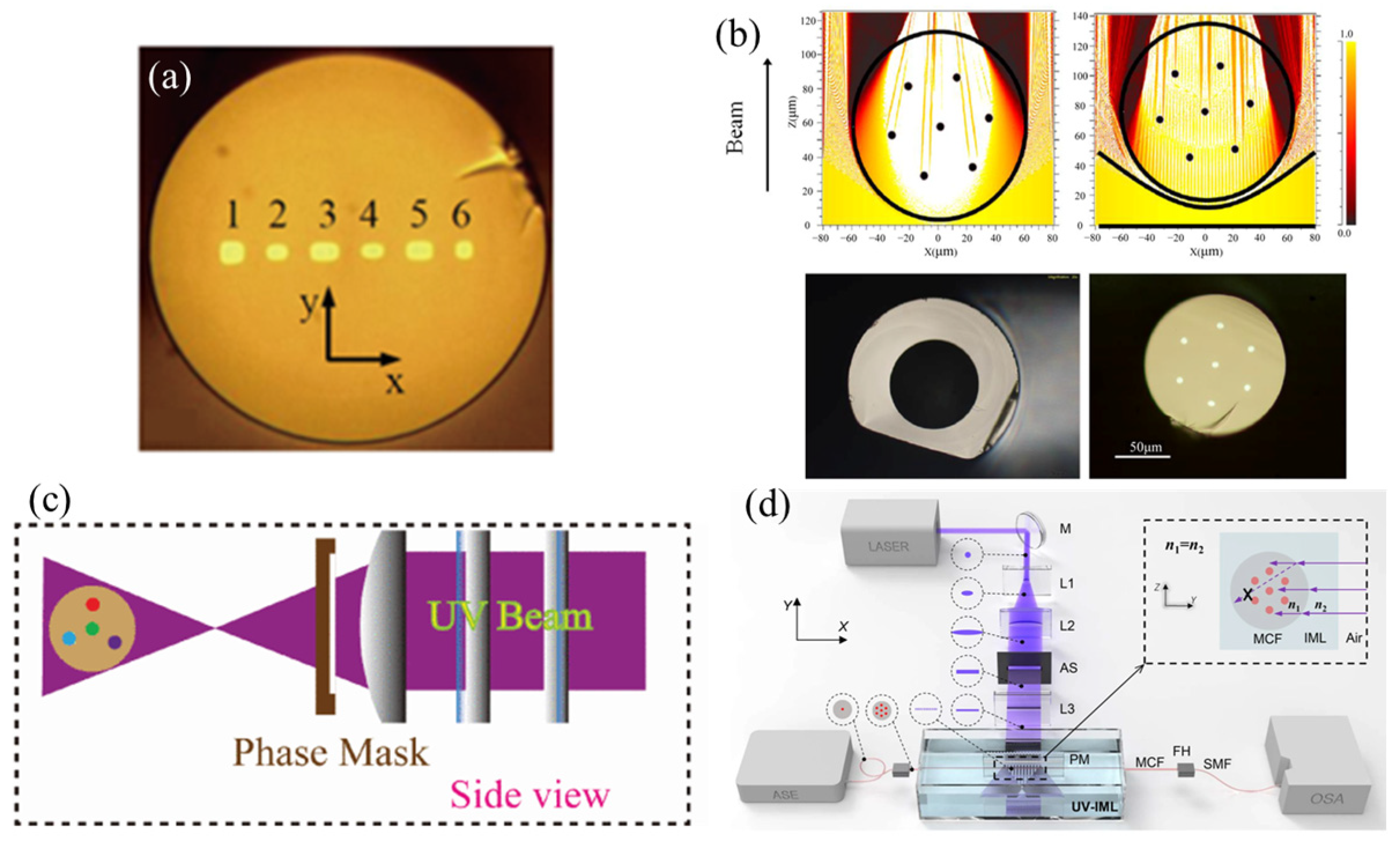
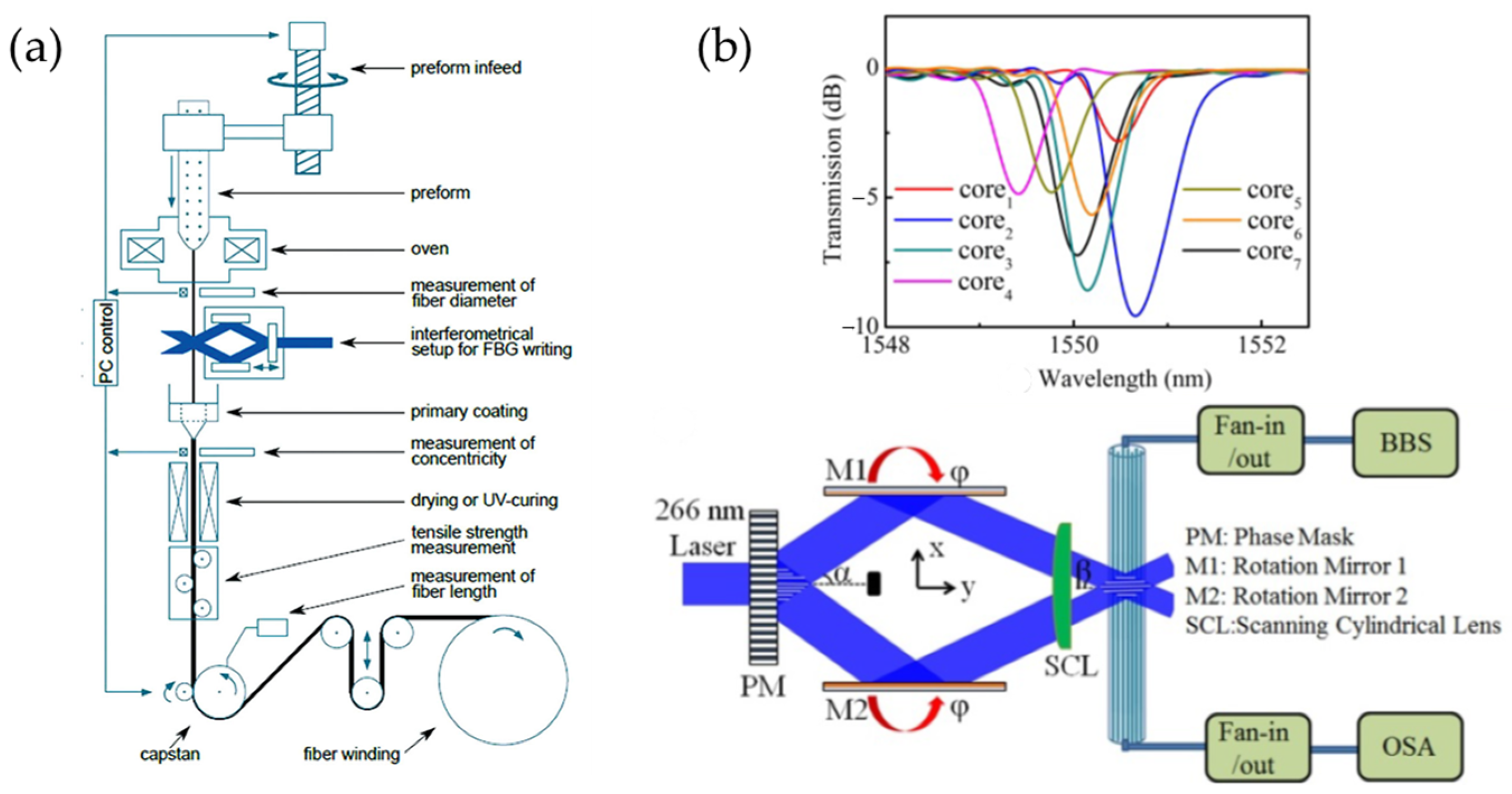
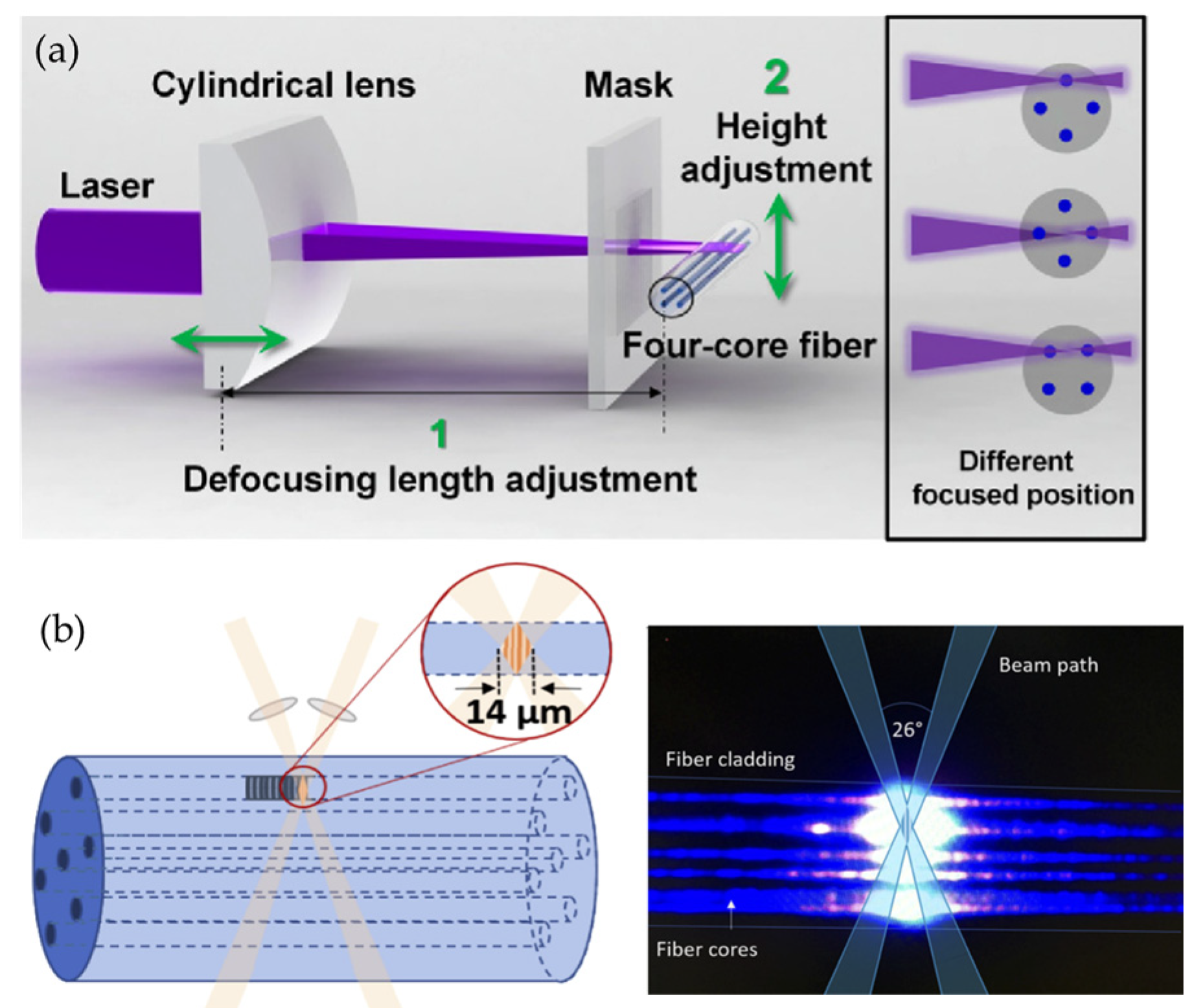
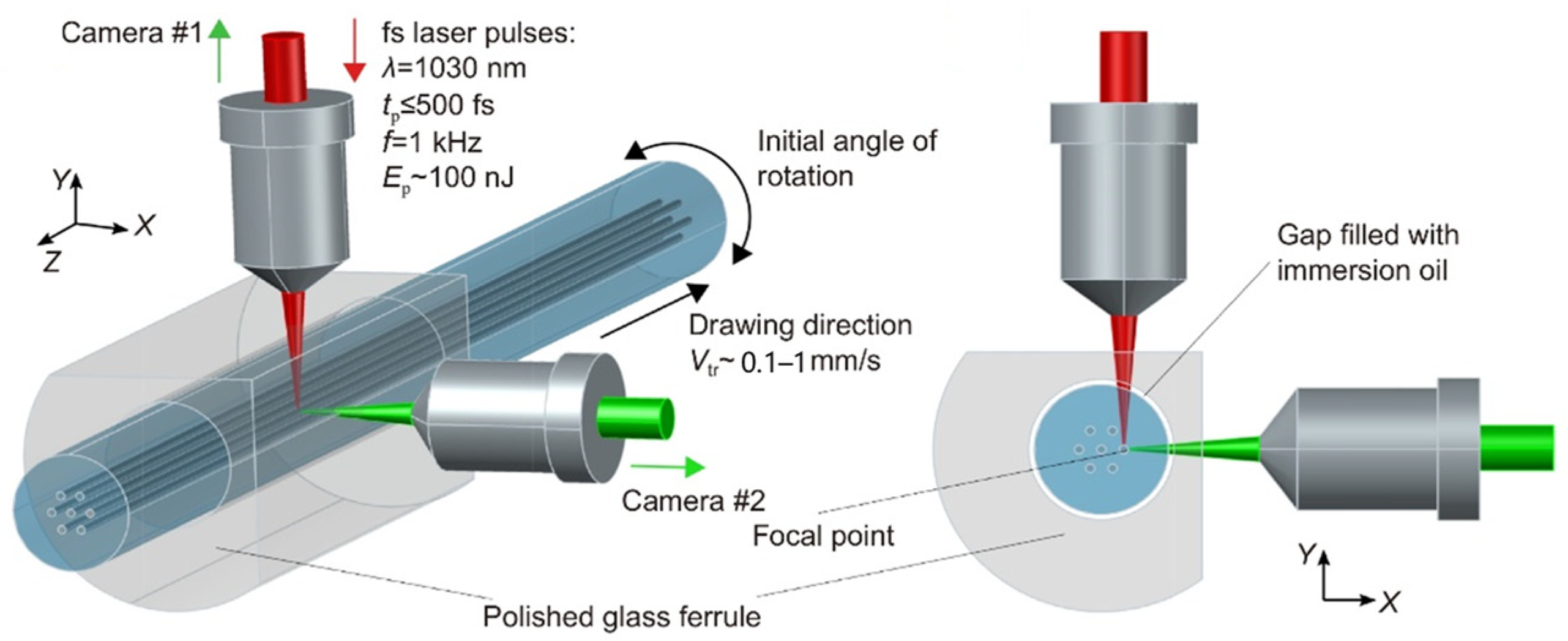

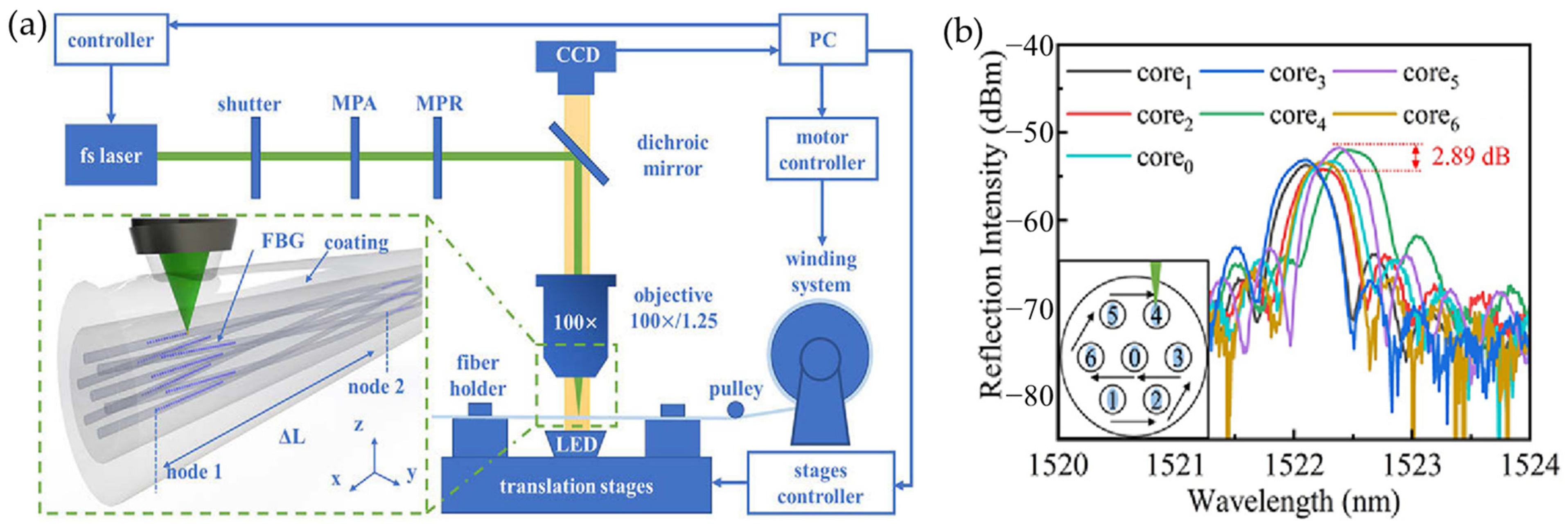
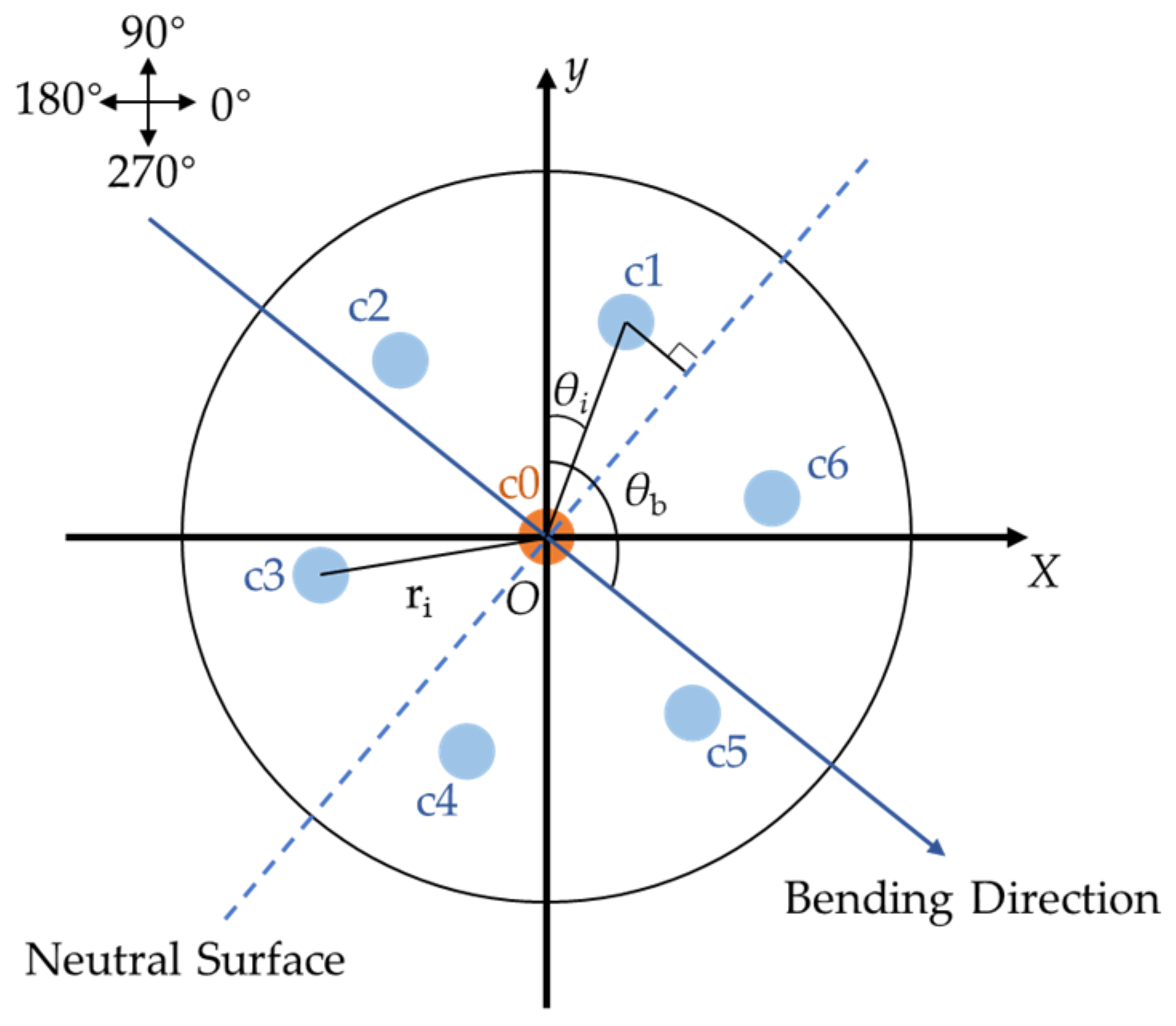


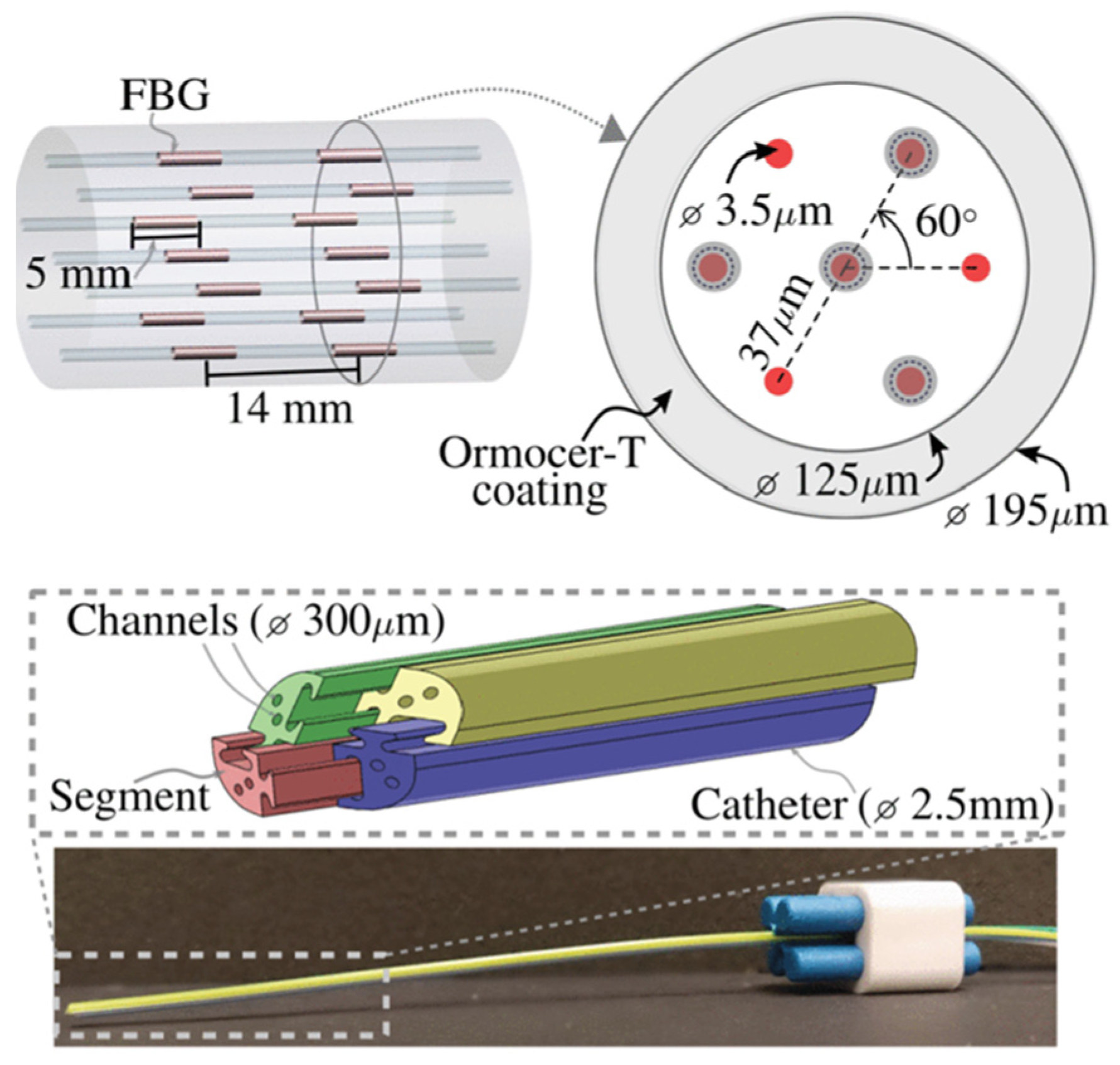
| Reference | Type of Optical Fiber | Method of Inscribing FBG | Features |
|---|---|---|---|
| [33,34] | Four-core fiber with square core arrangement | Phase mask method based on UV laser inscribing of full-core | Low production cost, fast production speed, poor reflectivity consistency |
| [36,37,38,40] | Seven-core fiber | Phase mask method based on UV laser inscribing of full-core | Low production cost, fast production speed, poor reflectivity consistency |
| [39] | Four-core fiber with triangular core arrangement | Phase mask method based on UV laser inscribing of full-core | Low production cost, fast production speed, poor reflectivity consistency |
| [44] | Four-core fiber with square core arrangement | Phase mask method based on UV laser inscribing of core by core |
High controllability, low production cost, complex production process |
| [45] | Seven-core fiber | Double-beam interference based on UV laser inscribing of core by core |
High controllability, low production cost, complex production process |
| [24,48,49] | Seven-core fiber | Point-by-point inscribing method based on femtosecond laser |
High controllability, high production cost |
| [50] | Dual-core fiber | Phase mask method based on femtosecond laser inscribing of core by core | High controllability, high production cost, difficulty focusing |
| [51] | Seven-core fiber | Phase mask method based on femtosecond laser inscribing of core by core |
High controllability, high production cost, difficulty focusing |
Disclaimer/Publisher’s Note: The statements, opinions and data contained in all publications are solely those of the individual author(s) and contributor(s) and not of MDPI and/or the editor(s). MDPI and/or the editor(s) disclaim responsibility for any injury to people or property resulting from any ideas, methods, instructions or products referred to in the content. |
© 2024 by the authors. Licensee MDPI, Basel, Switzerland. This article is an open access article distributed under the terms and conditions of the Creative Commons Attribution (CC BY) license (https://creativecommons.org/licenses/by/4.0/).
Share and Cite
Zhang, X.; Wang, H.; Yuan, T.; Yuan, L. Multi-Core Fiber Bragg Grating and Its Sensing Application. Sensors 2024, 24, 4532. https://doi.org/10.3390/s24144532
Zhang X, Wang H, Yuan T, Yuan L. Multi-Core Fiber Bragg Grating and Its Sensing Application. Sensors. 2024; 24(14):4532. https://doi.org/10.3390/s24144532
Chicago/Turabian StyleZhang, Xiaotong, Hongye Wang, Tingting Yuan, and Libo Yuan. 2024. "Multi-Core Fiber Bragg Grating and Its Sensing Application" Sensors 24, no. 14: 4532. https://doi.org/10.3390/s24144532





